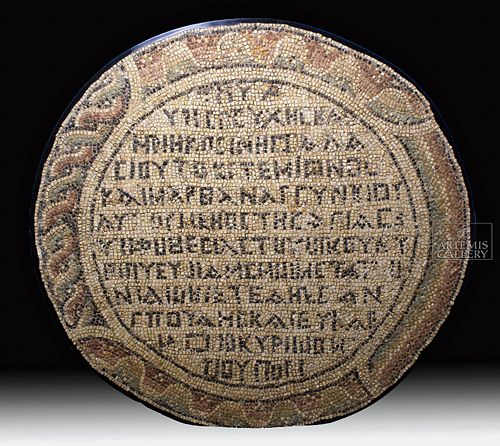Translated Roman Round Mosaic - Household Dedication
Lot 35
About Seller
Artemis Fine Arts
686 S Taylor Ave, Ste 106
Louisville, CO 80027
United States
Selling antiquities, ancient and ethnographic art online since 1993, Artemis Gallery specializes in Classical Antiquities (Egyptian, Greek, Roman, Near Eastern), Asian, Pre-Columbian, African / Tribal / Oceanographic art. Our extensive inventory includes pottery, stone, metal, wood, glass and textil...Read more
Categories
Estimate:
$26,000 - $39,000
Absentee vs Live bid
Two ways to bid:
- Leave a max absentee bid and the platform will bid on your behalf up to your maximum bid during the live auction.
- Bid live during the auction and your bids will be submitted real-time to the auctioneer.
Bid Increments
| Price | Bid Increment |
|---|---|
| $0 | $25 |
| $300 | $50 |
| $1,000 | $100 |
| $2,000 | $250 |
| $5,000 | $500 |
| $10,000 | $1,000 |
| $20,000 | $2,500 |
| $50,000 | $5,000 |
| $100,000 | $10,000 |
| $200,000 | $20,000 |
About Auction
By Artemis Fine Arts
Dec 2, 2021
Set Reminder
2021-12-02 10:00:00
2021-12-02 10:00:00
America/New_York
Bidsquare
Bidsquare : Fine Antiquities | Asian | Ethnographic Art
https://www.bidsquare.com/auctions/artemis-gallery/fine-antiquities-asian-ethnographic-art-7918
Features classical antiquities, ancient and ethnographic art from cultures encompassing the globe. Egyptian, Greek, Roman, Etruscan, Near Eastern, Asian, Pre-Columbian, Native American, African / Tribal, Oceanic, Spanish Colonial, Russian, Fine / Visual Arts, so much more! Artemis Fine Arts info@artemisfinearts.com
Features classical antiquities, ancient and ethnographic art from cultures encompassing the globe. Egyptian, Greek, Roman, Etruscan, Near Eastern, Asian, Pre-Columbian, Native American, African / Tribal, Oceanic, Spanish Colonial, Russian, Fine / Visual Arts, so much more! Artemis Fine Arts info@artemisfinearts.com
- Lot Description
**This is an oversized piece that may require special shipping. Please inquire for a quote prior to bidding.
Roman, the Levant, late Imperial Period, ca. 3rd to 5th century CE. A very special stone mosaic panel of a circular form with a household dedication composed of 12 lines of meticulously delineated Greek text surrounded by a decorative border featuring (from the top and clockwise): a passage of meander, a rainbow-like band, another passage of meander, and an interweaving meander - all in a beautiful palette of rose pink, russet red, sage green, beige, black, and white tesserae. The Greek inscription generally translates, "___ for prayer/vow and memory of Galasios ___ Mion (or "the younger") and Marthana with his son ___ of the holy ___ placement/dedication of the house ___ in fulfillment of a vow with their own (money) they went for ten years wherever ___ for the Lord (or master - not necessarily God) ___" Size: 52.25" W x 49.5" H (132.7 cm x 125.7 cm)
Scholars have noted that most of the recorded names of mosaic workers are Greek; in addition, Greek figural mosaics were adapted by the Romans; and many Roman mosaic inscriptions are written in Greek.
Mosaics (opus tesellatum) are some of our most enduring images from the Roman world, exciting not only for their aesthetic beauty, but also because they reveal what Romans chose to depict and see every day decorating their private and public spaces. This piece features a household dedication and may have been placed in the grand entryway known as the vestibulum or in the atrium where guests were greeted by their hosts.
In the Roman province of Syria, which encompassed most of the ancient Near East/Levant, mosaics developed as a popular art form relatively late, with most finds coming from the 3rd century CE or later. Syria was one of Rome's wealthiest provinces, but it was also far removed from Rome itself and Roman culture was overlaid on enduring cultural traditions from Hellenistic Greece and the great civilizations that came before it. Antioch-on-the-Orontes (modern day Antakya, Turkey) was the capital of northern Roman Syria, and its excavations in the 1930s revealed more than three hundred mosaic pavements - of which many embellished public baths. Popular mosaic themes from this region were often mythological or religious scenes, depicting gods and goddesses; however, sometimes mosaics were created to fit the theme of an edifice or room. This piece, given its household dedication, likely resided in a more public area of the home such as the vestibulum or atrium.
Provenance: East Coast, USA collection from a major New York art gallery, before 2011
All items legal to buy/sell under U.S. Statute covering cultural patrimony Code 2600, CHAPTER 14, and are guaranteed to be as described or your money back.
A Certificate of Authenticity will accompany all winning bids.
PLEASE NOTE: Due to recent increases of shipments being seized by Australian & German customs (even for items with pre-UNESCO provenance), we will no longer ship most antiquities and ancient Chinese art to Australia & Germany. For categories of items that are acceptable to ship to Australia or Germany, please contact us directly or work with your local customs brokerage most antiquities and ancient Chinese art to Australia & Germany. For categories of items that are acceptable to ship to Australia or Germany, please contact us directly or work with your local customs brokerage replace this
#139202Expected wear to tesserae with some loss, chips, cracks, and recessed pieces commensurate with age. Set in a modern plaster matrix with a metal frame.Condition
- Shipping Info
-
All shipping is handled in-house for your convenience. Your invoice from Artemis Gallery will include shipping calculation instructions. If in doubt, please inquire BEFORE bidding for estimated shipping costs for individual items.
-
- Buyer's Premium



 EUR
EUR CAD
CAD AUD
AUD GBP
GBP MXN
MXN HKD
HKD CNY
CNY MYR
MYR SEK
SEK SGD
SGD CHF
CHF THB
THB















